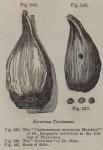 The fruit of this plant is the cardamomum majus of Valerius Cordus, [Hist. Stirpium, lib. iv. p. 195, 1561.] of Matthiolus, [Comment, in vi. lib. Diosc. Venet. 1583.] Geoffroy, [Mat. Méd. ii. 366.] Smith, [Rees's Cyclop, art. Mellegetta.] and Geiger. [Handb. d. Pharm. Bd. ii.] In Dr. Burgess's Collection of Materia Medica at the College of Physicians, there are several fine specimens marked "Cardamomum maximum Matthioli." (Fig. 245).
The fruit of this plant is the cardamomum majus of Valerius Cordus, [Hist. Stirpium, lib. iv. p. 195, 1561.] of Matthiolus, [Comment, in vi. lib. Diosc. Venet. 1583.] Geoffroy, [Mat. Méd. ii. 366.] Smith, [Rees's Cyclop, art. Mellegetta.] and Geiger. [Handb. d. Pharm. Bd. ii.] In Dr. Burgess's Collection of Materia Medica at the College of Physicians, there are several fine specimens marked "Cardamomum maximum Matthioli." (Fig. 245).
Under the name of Korarima, or Guragie spice, I have received specimens of the same fruit, which had been brought from Abyssinia by Major Harris's embassy, by Dr. Beke, and by Mr. Charles Johnston [Pharmaceutical Journal, vol. vi. p. 466, 1847.] (Fig. 246).
In former editions of this work, I followed Sir J. E. Smith, [Rees's Cyclop. vol. xxxix. Addenda.] in considering this fruit to be identical with the Amomum Madagascariense of Lamarck, [Encycl. Botan. t. i. p. 139, Ill. tab. i.] and the A. angustifolium of Sonnerat. [Voyage aux Indes, t. ii. p. 242.] As there is some reason to doubt the propriety of this proceeding, I have considered it advisable to designate the plant provisionally the "Amomum Korarima;" the word Korarima (pronounced in English Korahrééma), being the Galla name for the fruit which in Arabic is called Kkeil or K hü.
The capsule is ovate, pointed, flattened on one side, striated, with a broad circular umbilicus or scar at the bottom, around which is an elevated, notched, and corrugated margin. Some authors, who have mistaken the base of the capsule for its summit, have compared the shape to that of a fig.
Some of the fruits which I received from Abyssinia had been perforated and strung upon a cord (Fig. 246), probably for the purpose of hanging them to dry. Dr. Beke thinks that the pierced or perforated fruits are those which have been gathered before they were perfectly ripe. The seeds (Fig. 247) are rather larger than grains of paradise, roundish or somewhat angular, abrupt at the base, olive-brown, with an aromatic flavour analogous to that of the Malabar cardamom, but totally devoid of the vehemently hot acrid taste of the grains of paradise.
The Korarima is brought to the market of Báso, in southern Abyssinia, from Túmhe, (known among the native merchants as the "country of the Korarima") somewhere about 9° N. lat. and 35° E. long. It is carried to Massowáh, the port of northern Abyssinia on the Red Sea, and exported from thence to India. Dr.Rüppell was informed that the annual export is of the value of one thousand dollars (about £200 sterling). Although it is not impossible that the same fruit may grow in Madagascar, yet it is highly improbable that the Korarima of Abyssinia is the produce of Madagascar. [Dr. Deke, Pharmaceutical Journal, vol. vi. p. 511.]
At Báso, Dr. Beke purchased it at the rate of forty for one penny sterling.
The seeds are aromatic, and possess properties similar to, but more feeble than, those of the Malabar cardamom. In Abyssinia, they are used as a condiment and in medicine.

